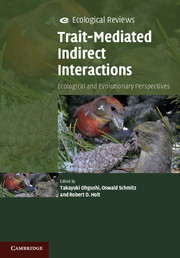Book contents
- Frontmatter
- Contents
- Contributors
- Foreword
- Preface
- Chapter One Introduction
- Part I Community
- Part II Coevolution
- Chapter Eleven Perspective
- Chapter Twelve Evolutionary indirect effects
- CHAPTER Thirteen Indirect evolutionary interactions in a multitrophic system
- Chapter Fourteen The role of trait-mediated indirect interactions for multispecies plant–animal mutualisms
- Chapter Fifteen Consequences of trait evolution in a multispecies system
- Part III Ecosystem
- Part IV Applied Ecology
- Index
- Plate Section
- References
Chapter Eleven - Perspective
trait-mediated indirect interactions and the coevolutionary process
Published online by Cambridge University Press: 05 February 2013
- Frontmatter
- Contents
- Contributors
- Foreword
- Preface
- Chapter One Introduction
- Part I Community
- Part II Coevolution
- Chapter Eleven Perspective
- Chapter Twelve Evolutionary indirect effects
- CHAPTER Thirteen Indirect evolutionary interactions in a multitrophic system
- Chapter Fourteen The role of trait-mediated indirect interactions for multispecies plant–animal mutualisms
- Chapter Fifteen Consequences of trait evolution in a multispecies system
- Part III Ecosystem
- Part IV Applied Ecology
- Index
- Plate Section
- References
Summary
Multispecific coevolution and the origins of coevolutionary trait-mediated indirect interactions
The notion of coevolution between interacting species can be traced at least as far back as Darwin’s writings in the Origin of Species, where he outlines a process of coadaptation between a plant and its pollinator (Darwin 1859). Although Darwin’s description of plant–pollinator coadaptation suggests a coevolutionary process, it was not until Ehrlich and Raven’s (1964) study of butterfly and plant adaptive radiation that the term ‘coevolution’ was coined. Ehrlich and Raven used the term to signify the broad concept of any evolution resulting from biotic interactions. This broad definition of coevolution persisted until 1980.
Under the broad definition put forth by Ehrlich and Raven, it is clear that trait-mediated indirect interactions (TMIIs) are part of coevolutionary thinking. TMIIs occur when a third species affects the traits involved at the phenotypic interface of an interaction between two species (Wootton 1993; Abrams 1995; Brodie 2003); this is the definition we will use throughout this chapter for TMII. Thus, using Ehrlich and Raven’s original interpretation of coevolution, TMIIs are a subset of coevolutionary interactions (assuming actual evolutionary change in trait values is occurring). TMIIs are often distinguished from density-mediated indirect interactions (DMIIs) where the third species alters the density of a species involved in another interaction and thereby alters the outcome of that interaction.
- Type
- Chapter
- Information
- Trait-Mediated Indirect InteractionsEcological and Evolutionary Perspectives, pp. 207 - 220Publisher: Cambridge University PressPrint publication year: 2012
References
- 2
- Cited by

